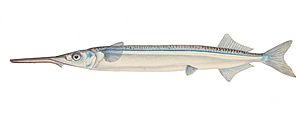Garfish facts for kids
Quick facts for kids Garfish |
|
|---|---|
 |
|
| Scientific classification |
The garfish, also known as the piper, is a cool fish called Hyporhamphus ihi. You can find it all around New Zealand. It loves shallow waters close to the shore. It's a type of fish known as a halfbeak.
Contents
About the Garfish
The garfish is a really unique-looking fish. It has a long, thin body and a very long lower jaw. Most garfish grow to be about 22 centimeters long. Their colors help them blend in. They have a greenish-blue upper body with brown spots. Their belly and underside are silver-white. They can even change their colors a bit to match their surroundings! A long silver stripe runs along their side, from their pectoral fin to their tail.
Garfish have several fins that help them swim. Their pectoral, dorsal, pelvic, and caudal fins are a bit dark. The anal fin is pale. The pectoral fins help the fish turn left or right. They also help the fish stay steady. The dorsal fin is located far back on the garfish. It helps them make sharp turns and keeps them from rolling over. Unlike many fish, the garfish's dorsal fin doesn't have sharp spines. Instead, it's soft, with cartilage veins that make it stiff when needed.
The pelvic fin helps the fish stop quickly. It also helps with general balance. This fin lets them dive into deeper water and rise to the surface. The caudal fin is the main fin for moving forward. It's also known as the tail. Garfish have a forked tail with a larger lower part. This is called a hypocercal tail. The anal fin is at the back of the body. It gives the garfish even more stability in the water.
The most special thing about the garfish is its long lower jaw. It often has an orange tip! Their upper jaw is usually longer than it is wide. The lower jaw is even longer than their whole head. This long jaw helps them feel tiny movements in the water made by their prey. Because their mouth is set far back, they are great at eating food from the water's surface. They also have two or three rows of teeth in both their upper and lower jaws. These teeth are called tricuspid teeth. They are found on the premaxillae, which are small bones at the tip of the upper jaw. They are also on the dentaries, which are bones in the front of the lower jaw that hold teeth.
Where Garfish Live
The garfish is special because it only lives in New Zealand. You won't find this exact species anywhere else! However, a similar fish, the southern garfish (H. melanochir), lives in Australia. Our New Zealand garfish can be found all around the country. They also live in the southwest Pacific and around the Chatham Islands. But they are most common in the northern and central parts of New Zealand's coastal waters.
Garfish like to live in shallow waters, only a few meters deep. They prefer calm areas like gulfs, bays, and large estuaries. You'll often find them around seagrass meadows or over shallow reefs. Even though garfish are found in many places, it's hard to count how many there are. This is because they swim in groups that stay in one small area. This makes it tricky for scientists to estimate their numbers.
Life Cycle
Scientists don't know all the details about the garfish's life cycle in New Zealand. However, it might be similar to its close relatives in Australia, like the southern garfish. We do know that New Zealand garfish are ready to have babies when they are about 22 centimeters long. They can grow up to 40 centimeters. They probably live for less than 10 years.
New Zealand garfish usually lay their eggs from late spring to early summer. They do this in shallow bays. The eggs then sink to the seafloor and stick to plants. After the eggs stick to the plants, tiny baby garfish, called larvae, might be found in coastal plankton surveys. It's thought that garfish eggs don't move around as much as other small fish eggs. This means that groups of garfish tend to stay in one area. This can make them sensitive to local fishing or changes in their environment.
What Garfish Eat and Who Eats Them
Garfish are omnivores, which means they eat both plants and animals. They munch on eelgrass and seaweed. They also eat smaller crustaceans, like tiny animals called zooplankton, mysids, baby crabs, and baby polychaete worms. Garfish are nocturnal planktivores, meaning they eat plankton at night. But they don't rely on their eyesight to catch food. They don't have a special eye feature called a tapetum lucidum, which helps some nocturnal fish see better in low light. Their pupils are small and filled mostly by the lens.
Garfish swim with a body that stays almost straight. This is linked to how they use their lateral line to find food. The lateral line is a special sense organ that helps fish detect movement and vibrations in the water. Because they have a strong lateral line system and don't rely on sight at night, scientists think their long beak might also help them sense prey. This idea suggests that garfish use their front lateral line system to find their food.
Because garfish swim in groups, called schools, they attract bigger fish and even mammals. Large fish like kingfish and dolphins sometimes hunt them. These schools of garfish also become prey for seabirds. Birds like gannets, shags, and penguins will try to catch them. However, it's unlikely that all three types of birds would hunt garfish at the same time. Which seabird hunts them depends on where the garfish are swimming. Garfish schooling in shallow harbor areas are more likely to be hunted by shags. Garfish in more open, deeper waters are more likely to be caught by gannets or penguins.
Garfish and People
Garfish were once a very important food source for early Maori people. They had great cultural meaning. They were not only eaten but also used as important bait for catching bigger fish, like yellowtail kingfish. Maori people usually caught garfish by dragging a finely woven flax net across seagrass beds in shallow harbors. They used a technique similar to seine fishing. One end of the net was held on the shore. The other end was pulled out in a big curve and then back to the shore.
Modern fishermen still use a similar method today. They drag a fine mesh net around shallow harbors. The garfish are often kept alive. They are then taken to other fishing spots. There, they are used as live baits for fish like snapper, kingfish, and kahawai.
Images for kids
See also
 In Spanish: Aguja para niños
In Spanish: Aguja para niños

